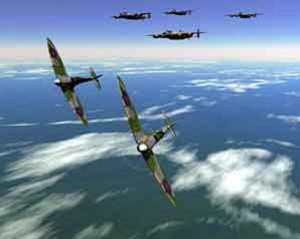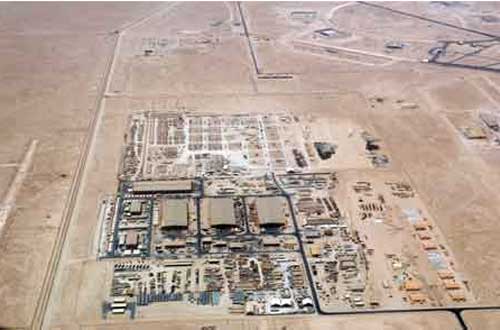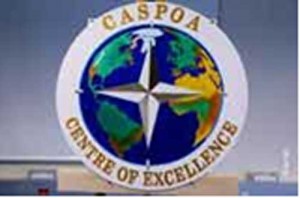A French View
By General Jean-Patrick Gaviard
10/09/2010 – This article, released here with the permission of its author, has been published previously by DSI magazine.
Credit photo: C2ISR/CAOC, Air Force Network Integration Center, USAF(www.afnic.af.mil)
After initially describing the “classic” operation of air command and control centers (C2) of yesterday and today, a more prospective vision of the C2 of the future will be developed in a second part. The vision will be within a more transverse framework and therefore more joint and interministerial highlighting the specific capabilities of airpower. A final part will focus on the men who will obviously be at the heart of the C2 operations of tomorrow.
The Operation of the “Traditional” C2
During the famous “Battle of Britain”, the Air Marshall Sir Hugh Dowding was commanding and controlling the air operations from his center of Stanmore, located north of London by unknowingly “spinning” the famous wheel: “Observation, Orientation, Decision, Action” (“OODA”) to be modeled much later by Colonel Boyd of the USAF, and which still prevails in the functioning of existing centers.

Therefore, the officers and the NCOs, in particular women (the WAAF), in place in the Stanmore C2 “observed ” at first the elements coming from different air watches posted on the English coast and from radars whose essential role in the success of this air battle will not be told enough. From those observations, officials could “steer” the action to come and then “decide” about the engagement plan. Specifically, this phase made it possible to alert the pilots of the famous Spitfire and the anti-aircraft guns affected by the attack to come, and to warn the units in charge of deploying balloons whose role was to interfere with German bombers shots on London. Finally, the control orders corresponding to the “action” phase were launched to stop the air raids detected previously. Everyone remembers the “scramble” or take off on alert of the very brave young British fighter pilots to whom Winston Churchill made a strong and moving tribute at the end of this historic air battle. In summary, the loop “OODA” turned overall as we are turning it today in modern C2. We also understand the fundamental role played by central command in this battle even if, traditionally, the Spitfire pilots are the ones credited with the success rather than its valiant orchestrator Air Marshal H. Dowding. Air Marshall happened to be sacked a few months later, for reasons of internal rivalries in the British High Command. Today, as a just reward, the Stanmore Center was opened to the public to pay tribute to Sir Dowding and to the C2 of the Battle of Britain.
The basic principles of C2 operation persist. But today in the face of asymmetric warfare, three new factors must be taken into account: the comprehensive approach, the tempo of operations, and the collateral damages.
Since September 11, 2001 the C2 in charge of “air defense” over the country have focused primarily on the terrorist threat type described as “renegade” by NATO. Thus, intelligence, which has become paramount in this new war against terrorism, requires a more transverse work, that is to say, more interdepartmental. Within the National Air Operations Center (“Centre National des Opérations Aériennes: CNOA”) of Lyon, for example, representatives of the Ministry of Interior and of the General Delegation to Civil Aviation (“Délégation Générale à l’Aviation Civile: DGAC”) have to play the interface with their department to increase interministerial synergy.
This transverse work allows the insertion of all state actors involved in the fight against terrorism in the same informative loop and to act more effectively. The “air policing”, more specifically, needs to anticipate the actions given the speed of the aircrafts and the fleeting nature of the threat, to engage resources on time and to inform the national policy maker, who in this case remains the sole judge of opening fire if necessary. In this context, bilateral agreements with France’s neighboring countries were signed to enhance this essential anticipation of action.
Meanwhile, in the C2 in charge of air operations over foreign theaters, particularly in Afghanistan, asymmetric warfare has now resulted in an acceleration of the tempo of operations. The principles of observation reinforced with evolved ISR systems remain here very relevant. Furthermore, more relevant targeting capabilities coupled with information exchange based on a Rover system, for example, between land and air components enable us to act with greater precision, while integrating the rays of lethality of the weapons on board. We must, indeed, know how to take into account the collateral damage that is routinely used by opponents via the media to influence public opinion. Thus, in some cases, the tactical air controller in contact with the ground troops (JTAC) can re-specify the target coordinates or, given the environment, cancel the shooting initially envisioned, and choose more appropriate courses of action, non lethal, such as “show of force”, for example.
But this work marked by the conduct in real time is not enough anymore. We must now “observe” even faster and in a smarter way to be able to make time to “orient” and “decide” that is to say, plan ahead and to “act” more accurately and therefore more efficiently in time and space.
During the Second World War, General Marshall admitted that if “40% of the art of command was based on the ability to improvise,” he also stressed that “60% resided in the ability to anticipate.”
The C2 of the Future
Current operations combine the joint modes of action through effects to be produced decided by the theater commander (“Joint Task Force”, JTF). In this increasingly joint context we can attempt to categorize different types of missions assigned to air power. This categorization provides insight into the role of “supporting” and “supported” played by the Air Component Commander (ACC) with other commanders, according to the effects desired by the JTF. These different categories can be described, for example, in descending order of their level of joint integration. If this hypothesis is accepted, then we can distinguish three categories of missions assigned to air power, ranging from the most joint mission to the most specifically air one:
- Joint support operations
- Control of the air
- Deep operations.
Joint support operations are today at the center of missions assigned to air power in Afghanistan. In this area, we must significantly improve the very centralized work procedures between the land and air components to anticipate future actions.
Air operations have been, since the end of World War I, primarily designed and controlled centrally and executed in a decentralized manner.
For reasons related mainly to their own characteristics and to the targets allocated to them by the theater commander, air operations are planned today in a very centralized way. The versatility of modern airborne delivery reinforces this centralization. Thus, in 2003, U.S. forces often used the same F15E and F16 aircrafts based in the Gulf emirates to act in Iraq and Afghanistan. It’s for this historical reason that air operations related to operations Iraqi Freedom and ISAF in Afghanistan are still lead from a single C2 located on the Al Udeid Air Base in Qatar.
 “The air operations related to operations Iraqi Freedom and ISAF in Afghanistan
“The air operations related to operations Iraqi Freedom and ISAF in Afghanistan
are still lead from a single C2 located on the Al Udeid Air Base in Qatar.”
Credit photo: Al Udeid base, http://gc.nautilus.org
However, this hyper-centralization may be woefully inadequate when it comes to missions in direct support of ground forces. These missions are currently planned in “series” by the land first then air officials, and not in an integrated manner. Thus, the air-ground coordination in Afghanistan weights primarily on the “shoulders” of a tactical air controller (JTAC) who must, in case of an emergency request, finely describe, under fire, the complex situation on the ground to pilots who came to assist and with all the difficulties that we can imagine including fratricide kills. However, we can imagine solving this difficult problem more effectively by a collaborative work of integrated planning done well in advance between the concerned tactical air and land units. This decentralized and more appropriate planning can only be achieved if the concerned tactical leaders have at their disposition better collaborative working tools and a relevant land and air “situation assessment” that can be found today at the central C2 level in order to act knowingly.
One can easily imagine that thanks to modern means of communication, we will soon be able to “move” the situation assessment to the tactical level and therefore “decentralize” the planning of some joint support air missions.
However, the air commander will obviously be able to “regain control” if the situation required it in order to redistribute the tasks according to new desired effects. The air commander’s responsibilities would therefore be, in this case, more toward monitoring than strict control under the “command and control sense, allowing it to stand back from events in real time, at a tactical level.
Mastery of the third dimension is total in Afghanistan. We must not, however, deduce consequences too hastily regarding future operations. Everyone remembers the tragic bombing carried out in 2004 against French forces in Bouake (Ivory Coast). The mastery of this third dimension or aerospace is often wrongly forgotten. But without air superiority, there is no “freedom of action” for the other forces, primarily terrestrial. One can easily imagine what operations in Afghanistan could be like without the full control of the sky available to the coalition forces today. Regarding the control of the airspace itself, it is clear that the air commander has recognized expertise in that field. Indeed, in most operations, the joint theater commander gives from the outset this responsibility to the air commander. Beyond the full responsibility, we must also understand the need to coordinate in the same airspace, the means used by other components, especially helicopters and drones. It is not about interfering with the tasks assigned by another command but rather to coordinate actions in the third dimension with a main goal of security and more particularly of anti-crash.
Without air superiority, there is no ‘freedom of action’ for the other forces, primarily terrestrial. One can easily imagine what operations in Afghanistan could be like without the full control of the sky available to the coalition forces today.
Finally, tomorrow the C2 vested in the anti-missile ballistic defense (AMBD) will have to act seamlessly with the C2s responsible for air defense to coordinate the production of the different aerospace effects. There clearly is, in fact, a common “DNA” between these two C2.
In-depth operations characterize in a unique way the aerospace power. Indeed, only aerospace power can provide policy makers with strategic information, weigh on the opponent, and deliver effects within hours anywhere in the world with a minimal or even absent footprint. The long-distance exercises called “Iroquois”, conducted by the Command of Air Defense and Air Operations (CDAOA) using Rafales equipped with cruise missiles accompanied by an Awacs, tankers and equipped with means of long distance communication illustrate this unique strategic capability. Indeed, this COMAO (“Composite Air Operation”) can not only move towards its initially programmed destination but can also be recalled or diverted in flight at any time based on the strategic effects desired by the policymaker.
In a more prospective way, work undertaken by the command of NATO Transformation (SACT) in Norfolk regarding future air C2 highlight the need to develop collaborative work with other components or with interdepartmental agencies or nongovernmental organizations (NGOs).
This collaboration can be achieved by relying on robust and meshed communication networks to create “a C2 constellation” with the needed situation assessment to plan at the required level and in a transverse way missions with other components, other government departments or NGOs if needed, as it was previously presented.
On another level, “rare” capacities management among several theaters of operations has also emerged. Strategic transport, cyber defense, use of MALE type UAS, anti-missile ballistic defense, and satellites are part of those capabilities that go beyond the specific regional context in essence.
These capabilities are highly strategic and will likely remain under the command and control of countries that provide these resources to benefit the Alliance. As a corollary, they probably will not be put under the command or the direct control of a NATO C2. It is therefore appropriate to consider a new fundamental principle of unity of effects. In this context, the “air C2 inter theaters” will have the responsibility of managing and coordinating those strategic assets but without having direct control over them.

In summary, we know that if the command keeps all its relevance through production of effects, the control is changing in favor of a more collaborative vision. It should be noted that General Mattis, the predecessor of General Abrial as head of the General Staff of NATO Transformation in Norfolk, preferred to use the term “feedback” rather than “control”. The C2 acronym may therefore gradually evolve from the term “command and control” to “command and coordination” and to “command and collaboration.” Note, finally, that the current work focused on new concepts of C2 air will, undoubtedly, have a direct impact on land and sea and of course joint C2 organizations.
The Men: Toward a New Generation CASPOA
Beyond all these conceptual issues and the exponential advances in information technology, it should be borne in mind that men are and will remain at the center of the device. General Montgomery emphasized this point by defining the command as: “the ability and willingness to rally men and women around a common goal.” Cultural change and training will therefore remain central to driving these transformations.
The C2 are real weapon systems and must thus receive appropriate training methods, what had been fully understood by the Air Force officials who had already created more than fifteen years ago the Centre of Analysis and Simulation for Preparation of Air Operations (“CASPOA”)dedicated to the training of all personnel serving in the Air C2.
To anticipate the advances in terms of C2, the CDAOA already works at a New Generation (NG) CASPOA. The path is now marked.
(Credit photo: Al Udeid base, http://gc.nautilus.org)

